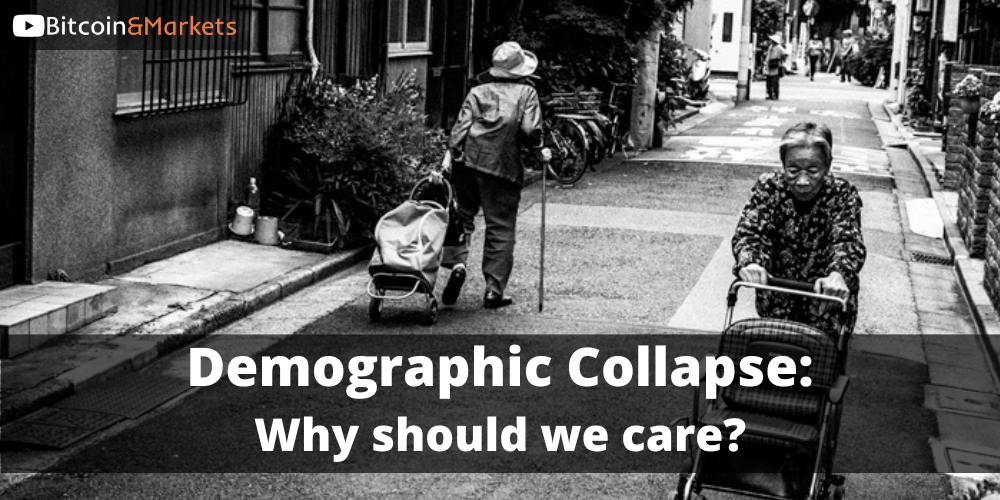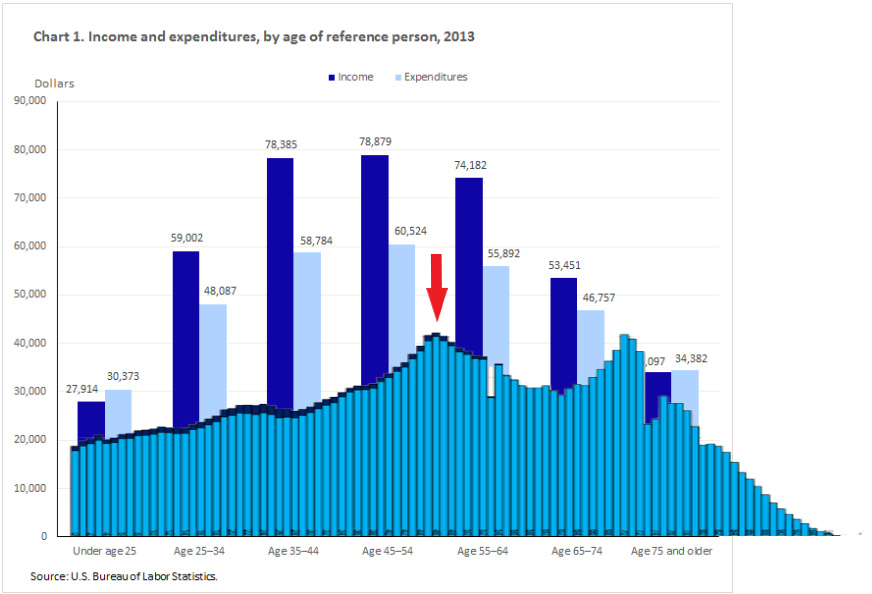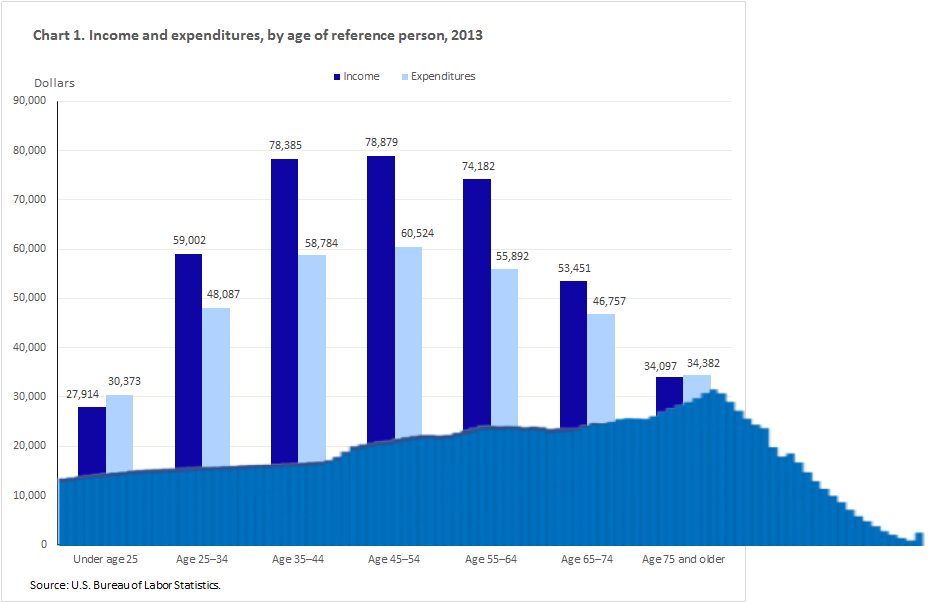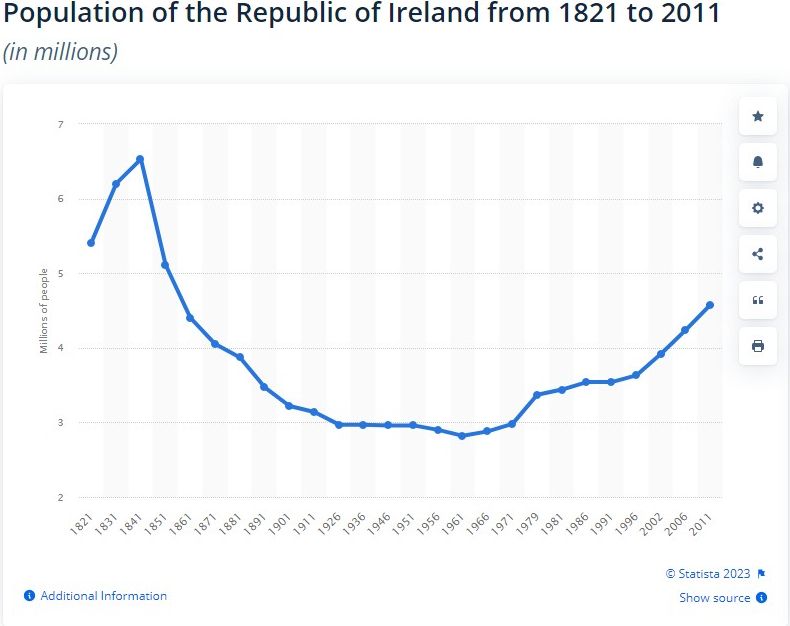Demographic Collapse: Why Should We Care?
There's a demographic decline coming, but why should we care?

Discussion of the world's demographic challenge has gone from obscurity to intense debate in just a few years. Rightfully so, in my opinion, it will be one of the defining topics of the 21st century.
For those new to this topic, we are not talking about a Malthusian overpopulation bomb. Almost the opposite. We are talking about the inevitable slow creep to aging and underpopulation. If Malthus' 1798 prediction is 'going out like a bang', demographic decline is a whimper.
The Future is Not What You Thought
If you are anything like me, you enjoyed sci-fi growing up. Shows like Star Trek, movies like Star Wars, flying cars, space stations, Sigourney Weaver fighting aliens, world-spanning cities, linear advancement to the future. I imagined a future with far more abundance, technology, exploration, and understanding. However, in 2023, it has become painfully obvious that kind of future is only a childish fantasy.
More recent sci-fi is slightly more realistic in this direction, one might say. The popular series The Expanse for instance, has no warp drive or hyperspace, no artificial gravity, and portrays life in space as living on the edge of survival. However, even The Expanse is based on a future with vastly more human beings. Earth has 30 billion people, with another 5 - 10 billion on Mars. It wouldn't make intuitive sense to have all that technology and there be, say, 1 billion people. It's as if we inherently know progress requires an expanding population. Or that economic and technological growth goes hand in hand with population growth. As of now, we will never get there. It appears our future is an ever shrinking population.
The human race will not go extinct from this, I don't go that far. As a whole, we will figure it out, but extinctions of some unique and beautiful cultures and nations are likely. South Korea, for example, is facing a 95% population decline in the next 100 years. Their government projects the extinction of 96.5% of their urban areas by 2117. Nothing has worked to stem the tide, it's only getting worse, year by year. Their fertility rate hit a staggering 0.78 so far in 2023. Down from 0.82 in 2022.
A very different view of the future is starting to emerge, not the sci-fi future of incremental improvement in technology, living standards and political organization, it is much more bleak. The coming 100 years will see the global population first age, then decline at a rate that precludes higher living standards and technological advancement. Just maintaining our current standard of living as a globe is very unlikely.
In this post, I explain the problem in more detail. From why robots won't save us to why depopulation is bad for the planet. We, as a human race, will have to experience pain to a degree that makes us fundamentally change the technological or social causes of this collapse. If we don't change, depopulation will continue to march forward, consuming more and more of our living standards. Many cities and even countries will find it hard to feed their people and keep the lights on.
This is planned as a two post series. In my next post, I will tackle some solutions to the demographic problem with humility, but to do that, we must accept the problem exists in the first place. The way a generational problem works is once we accept we have a problem, it will take an additional 40-50 years to solve the issue.
So What?
The typical reaction you get when trying to discuss the severity of the demographic situation is, "so what?" It's hard to summarize such a broad topic, but I often respond like this: imagine fewer people doing fewer things, each generation, until disaster. Above, where I said some places will have trouble keeping the lights on, I wasn't kidding. There will be fewer engineers to run and maintain the power plants, fewer line technicians to fix power lines, fewer electricians to run the wires, fewer people to purchase the electricity making the power plant unprofitable in the first place. We saw this exact thing in Detroit, but more on that below. It's a snowball rolling downhill. Infrastructure needs people to invest in it, to maintain it, and to use it. With an ever-decreasing demand, the infrastructure calculus breaks down.
Another example is roads. We will have fewer people driving on the roads, fewer people paying taxes for upkeep, and fewer people to fix them. Roads that aren't maintained will become impassable in short order. Even a well-maintained asphalt road will only last 20-30 years. We will see fewer miles of passable roads each year, which will increase transportation costs for trucks with fewer drivers to drive them.
Some might say, 'we can redesign the roads or power grids more efficiently.' Those people have not yet grasped that we will have fewer people paying for, doing, and demanding less.
Entire industries and supply chains will become uneconomic. Say a supply chain that runs through 15 countries before the widget makes its way back to the US consumer. The production process became so complex because the producer could cut costs by doing so. As demand shrinks because there are fewer consumers, and costs rise because fewer sailors, truckers, and low income foreign workers. The complex supply chains quickly become uneconomic. If the product cannot be produced domestically it might not be produced at all.
People often think the "greedy capitalists" can stand to have their fat cat margins squeezed a little bit. People don't understand how narrow margins actually are. Below are some highlights of a list of industries in the US and their net margins. Imagine, demographic collapse squeezing margins by 10%, great swaths of industry will require massive overhauls (with fewer people to do the work required) or shutting down all together.
- Trucking - 1.29%
- Groceries - 1.96%
- Education - 2.92%
- Farming - 5.66%
- Average of all - 8.89%
Understanding Economic Decline
Economic growth is easy for people to understand. More people doing more things, creating more wealth, supporting more credit, resulting in rising living standards. The reverse is much harder to conceptualize (outside of a communist hell hole). Fewer people doing fewer things, creating less wealth, supporting less credit, resulting in lowering living standards.
This isn't like a plague or a war where once the event is over, things return to business as usual. If that were the case, population would naturally stabilize, people would return to the same professions, same activities just with fewer people, bankers would return to lending, etc. Demographic collapse is different, because the new normal is a slow creeping population loss, year after year. The "event" never ends. All people can look forward to is it getting worse next year.
I'll apply a couple concepts from economics to hopefully drive the point home. Many people understand network effects in technology. Each new member that joins a network increases the value of the network for all existing members. Metcalfe's Law says the total value of the network increases exponentially as new people join. For instance, a network twice as large will be four times as valuable because there are four times as many connections.

The reverse of Metcalfe's Law is also valid and is what we are facing. The value of a network collapses rapidly as people leave the network.
Metcalfe’s law applies in reverse as well. As nodes leave a network, the value of the network falls rapidly. For every node that leaves a network, every remaining node has one fewer possible connection. - River Financial
If you think of an economy as a large network, as population grows, benefits accrue to the entire network (usually measured by GDP). Granted these benefits are not equally distributed in most cases, but living standards rise for the society as a whole. We have more inventors, more scientists, more teachers, more communication, more positive externalities, more entrepreneurs, more and faster everything.
What a demographic collapse means is the forced unwinding of those network effects. As the population shrinks, you get progressively greater negative feedback effects. It is fewer inventors, fewer scientists, fewer teachers, fewer entrepreneurs, fewer laborers, less and slower everything.
Another analogy from economics is economies of scale. This is where cost per unit goes down with added scale, due to dividing fixed costs between more units of output. Producing more units lowers the price to the end consumer for an individual unit, helping them afford more things, and increasing their standard of living.
Economies of scale are lost with fewer people doing fewer things, demanding less, etc. The economies of scale that have been so beneficial in the last 200 years, were enabled by rising demand, and will reverse on the whole with falling demand. Why produce more if you can't sell them? As the number of units goes down, the price to the end consumer will go up, making it so you can afford less, decreasing your standard of living.
This might seem too bleak, but you only have to look at some South Korean or Japanese cities where we already see these exact devastating effects. It will not happen at the same speed everywhere. Some places might experience temporary economic booms along the way, or even stave off the worst effects for 50 more years, as I expect for the US. But as a whole, the world is already beginning this trend, and we don't know how to stop it without radical change.
Can't Robots Help?
Of course, robots or automation will save us! Right? No, robots do not supplement demand, they only add to supply. Adding supply does not fix a demand problem. The market response to falling demand will be price declines followed by declines in supply. This is the automatic market healing function. If you meet falling demand with rising supply, you get misallocation and economic crises.
When speaking about demographic decline, most people only consider labor shortages. However, falling supply is the result of declining demand, and robots do not fix that.
Robots need people to make them and repair them, but we have fewer people doing fewer things remember. Robots are cheaper to operate perhaps, but are more expensive up front. You'll need credit to finance their development and installation, access to which is decreasing in a shrinking world. The up-front cost also requires a positive return on investment (ROI), which will be much less certain as global demand is collapsing and profits are uncertain. Lastly, robots rely on the lights staying on, again, not a given.
The idea that robots will save us from this demographic challenge is based on a lifetime of ever increasing GDP and standards of living. Robots are great for booming economies where demand is increasing and workers can level-up to new valuable specializations, letting robots take on the menial jobs. However, as economies shrink, those valuable specializations slowly disappear, division of labor goes in reverse, and robots become direct competition for people they are supposed to be serving.
Aging and Its Effects
Poor demographics is not a cliff, it is more of a wave. People don't simply die, they grow old first. That is precisely why a demographic collapse is hard to see until it's too late, and also why it is hard to get people to pay attention to it. It happens slowly but relentlessly, like a tsunami. People keep getting old and workers keep disappearing.
Our prime productive years are between 35-65 years of age. Once we retire, our income is usually fixed-income, living off investments, drawing down on the capital stock of the economy. Our consumption drops off as well, but not as fast as our income. The major consumption period of our lives is also 35-65, when we are starting a family (maybe), buying a home, cars, travel, etc. Retired people tend to be on tight budgets compared to those in this prime productive age group.

On the below image, I overlaid half of the demographic pyramid for Japan onto earnings by age group (granted this is earnings by age for the US, but Japan is likely similar). The red arrow is the population bulge saving them from collapsing today. That age group is around 50 and will exit their productive years in 15 years. After that, it is game over for Japan.

The estimated demographics for Japan in 2050 show the grim future. Don't forget, this has been locked-in, because the people replacing the prime age bulge would already have been born by 2015. That didn't happen, in fact fertility rates continue to fall. Who is going to do all the work? Who will take care of the old people?

Lastly, we need to talk about pensions and 401k's. The elderly rely heavily on these sources of income in retirement. In turn, pensions and 401k's rely on market returns and asset management, and are exposed to those types of risk.
A defined benefit pension plan provides a fixed, pre-established pension benefit for employees upon retirement, and the employer carries the risk that assets invested in the pension plan may not be sufficient to pay all benefits. Companies must forecast the dollar amount of assets available to pay benefits required by a defined benefit plan. - Investopedia
Most pensions invest in government securities, investment-grade bonds, and blue chip stocks to minimize risk and maximize predictability. However, if we are entering a period of sub-par economic growth, returns on safe and liquid assets are typically lower. You get into a trap where pensions are not able to meet their promised benefits. 401k's will also suffer from sub-par economic growth.
There is a whole Wikipedia page on the pension crisis:
The pensions crisis or pensions timebomb is the predicted difficulty in paying for corporate or government employment retirement pensions in various countries, due to a difference between pension obligations and the resources set aside to fund them. The basic difficulty of the pension problem is that institutions must be sustained over far longer than the political planning horizon. Shifting demographics are causing a lower ratio of workers per retiree; contributing factors include retirees living longer (increasing the relative number of retirees), and lower birth rates (decreasing the relative number of workers, especially relative to the Post-WW2 Baby Boom).
The largest elderly benefit programs are Social Security and Medicare. I probably don't have to tell you that the estimates for unfunded liabilities for the US government should alarm everyone.
Thus, with Social Security and Medicare included in the assessment, the federal government’s unfunded liabilities in 2021 are $93.1 trillion, or nearly 400 percent of annual GDP. - James C. Capretta, Senior Fellow American Enterprise Institute and Milton Friedman Chair
Local and State governments are even worse. The US is in the best demographic situation of advanced economies, and yet we have this bad of a problem. Imagine, the rest of the world.
The math is clear, as a society, we will have to support more unproductive elderly with fewer productive workers in a less vibrant economy.
Historical Comparisons
There have been few historical comparisons to the demographic collapse we are facing. I've selected three different events to highlight for our purposes, that will help us find patterns in the outcomes in order to predict the course of the current demographic emergency.
The Black Death
The Black Death was a bubonic plague that struck Eurasia and North Africa from 1347 to 1352. Plague reoccurred at various times and places until 1400. All told, 25% of the global population died. Europe being the hardest hit. This is a massive topic but I want to focus on population decline and the fallout directly from that.
"Europe’s population in 1430 may have been 50-75% percent lower than in 1290." (source) The population of Europe would not return to pre-plague numbers until approximately 1550.
Estimates are 1/3 to 1/2 of the European population died during those few short years, and certain regions suffered more than others. While the scarcity of labor helped to push wages higher for those who survived, tax increases offset those gains and, importantly, overall production plummeted. International trade during the mid-14th Century became dramatically one-sided. Silver streamed out of Europe to the Near East, as it became Europe's major export. - History of World Reserve Currencies: Part 2 - The 14-15th Century Silver Shortage

Most people with whom I've discussed this topic consistently bring up the fact that wages rose during this time because of a shortage of labor. Peasants had bargaining power they didn't have before. While that is true, it wrongly ignores the other side of the equation, demand fell. Trade nearly stopped during those years, the amount of land under cultivation dropped, prices and taxes went up, and many landowners were ruined and couldn't organize peasant labor leading peasants to leave for greener pastures, literally.
A competition arose around keeping peasants on your land. With wage and tax pressure, landowners often competed on services they could offer. The poor often fled the cities into the countryside, which resulted in supplementing the rural population. There was social unrest and a search for the source of the suffering. Some people blamed themselves and sinners, others blamed Jews, forcing many Jews to flee east into Poland. Several large-scale riots broke out in major cities as the poor became discontented with the treatment by the elites.
The drop in output in Europe was more than other places, because it was disproportionally hit by plague. There were no surplus agricultural production or retail goods to export. Silver became the biggest export, leading to even more of a silver shortage and harsher taxes.
Ireland
Numbers differ but it is generally accepted that Ireland had at least 6.5 million people prior to the Great Famine in the 1840s and 1850s, at which time it fell to around 3 million.

During the Great Hunger, roughly 1 million people died and more than 1 million fled the country, causing the country's population to fall by 20–25% (in some towns falling as much as 67%) between 1841 and 1871. Between 1845 and 1855, at least 2.1 million people left Ireland, primarily on packet ships but also on steamboats and barques—one of the greatest exoduses from a single island in history. - Wikipedia
You can see, there is disagreement on the exact figures, but the decline in a 30-year period was somewhere around 50%. That is faster than our modern day demographic problem, but Ireland has never recovered to that previous high population. In 2021, it finally broke 5 million but their fertility rate is in contraction territory of 1.63.
This decline was brought about by the potato blithe and famine, but some of the patterns are the same that we'll see in the future. Many people emigrated. There were riots and fights over imports and exports. During these years, Ireland still exported tons of food to Britain.
We do have an example in modern times that we can look at more closely for those patterns.
Detroit
Detroit's population peaked in 1950 at 1.8 million people and today it stands at only 630,000. Decline culminated in the city declaring bankruptcy in March 2013 and the city government being taken over by the state of Michigan.

Detroit's downfall can be traced to the decline of General Motors. However, it is a great example of the downward spiral that population collapse can bring.
As the city's tax base shrank the quality of schools, infrastructure, and public services also declined. This led more people to leave and tax receipts to fall even further.
To tie Detroit into my infrastructure discussion above about keeping the lights on, post-bankruptcy in 2014, only 40% of the city's street lights worked. One of the major programs at the time was getting them fixed. It took a concerted effort over 2 years to do so.
After the 2013 bankruptcy the city of Detroit set up a Land Bank which ended up owning over 95,000 structures and lots that had been abandoned over the years. Most of those condemned and in need of demolition. They also auctioned some properties from their website for $1 at the time.

It's said that swaths of the city have been abandoned and being reclaimed by forest.


Detroit's downward spiral has slowed. There is revitalization in the downtown and demolishing abandoned structures have eased strain on the city budget. It's still far from making a lasting revival, because it suffers from the same demographic trap as everywhere else.
It is also a very localized event. Detroit had the rest of the country to rely on. It's situation was never seen as terminal because they could turn it around and attract people back to the city. Imagine if everywhere was Detroit. No city can turn it around and attract people back, because every city is losing population.
Once again, we see some patterns. Mass emigration and corruption are the two biggest themes we see repeated here.
It's decline was also more rapid that the global decline that is coming. It lost 65% of its population in 70 years, where the developed world as a whole is on pace to lose roughly 50% in 100 years. However, some places that are declining more rapidly, could lose more people due to emigration to places with better outlooks. Detroit is what could happen to most of South Korea, Japan, China, Germany, Italy, Russia, over the next 50 years as the last few productive people in those places flee to even slightly greener pastures.
We're Killing the Planet
I don't want to get too controversial in this post. It isn't a climate blog, but I will briefly respond to this shallow dismissal. Science is not done by committee or consensus, committee and consensus is in fact the antithesis of the scientific method. When you hear someone say 97% of scientists agree, disregard their point completely, and perhaps the person making the argument, too, because they are delusional.
The evidence seems to point in the other direction. The earth is greener today than a few decades ago, climate and sea-levels have not shifted out of historical norms, and climate-related deaths have plummeted as alarmists fear-mongering has skyrocketed.

On top of that, population figures alone point to a self-contradiction in their argument. We are to believe that our population and economies have soared while we have been making the earth less hospitable to humans? Each iteration of climate alarmism has a D-day that comes and goes with nothing significant happening, yet we have more humans, fewer climate-related deaths, and higher living standards than before.
The facts say, the Earth becomes more habitable the more people we have. More safe, not less. This is a very important point for the affects of moves in the contrary direction, too. My explanation for why Earth becomes more habitable the more people there are, is because we have more people doing more useful things, more science and more climate mastery. Greater division of labor increases efficiency. A rising population makes the world more habitable, not less.
Is there some pollution that is a problem, like air quality in some places or plastic in the oceans? Most definitely, but those problems will not get better with fewer people. Their argument is exactly backwards. With fewer humans there are, the less habitable the Earth becomes for those people and other organisms remaining. We will be poorer and less able to save the planet.
Conclusion
Hopefully, I've made a strong case for why you should care about our demographic challenges. They aren't equal in intensity everywhere but they are universal. If you still don't think it's a big deal, just wait a decade when the signs will be even more undeniable. I am beating the drum on this today, because it is a generational problem that takes a very long time to fix. We need 40-50 years to turn this around, and the longer we wait, the more locked-in the economic crisis becomes.
In the developed world, population will halve in the next 100 years. Some places much faster than that as emigration sucks the lifeblood out of those economies. Fewer people means much lower demand to sustain standards of living, investment and retirement income, as there are more old people and fewer young people to support them. The positive network effects, economies of scale, and division of labor that built the world into this miraculously high standard of living are being unwound.
The free market won't save us. This crisis IS the free market reacting to the distortion of the last 75 years.
It won't be a straight line. We will have some good years and bad years. However, demographics are destiny. If you want your family, people or the planet to thrive, you have to start asking some very hard questions. It's not as easy as "bitcoin fixes this". Bitcoin will benefit and be part of the solution, but that's for the next post. It will be dedicated to how we fix our demographics challenges.




